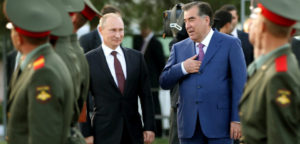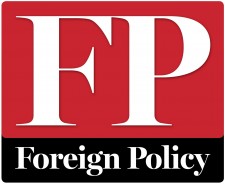By
On May 22, the people of Tajikistan — a former Soviet country of 8 million people nestled in the heart of Central Asia — went to the polls. Not to elect a new president or vote for a new parliament, but to decide on whether to make the country’s current president, Emomali Rahmon, president-for-life. The referendum passed in a landslide — with 94.5 percent of votes cast in favor of the change.
Addressed as “your excellency” and referred to as a “great hero” in state media, Rahmon — a former Soviet-era collective farm boss who oversaw the region’s lucrative cotton production — is the closest thing the Central Asian country has to royalty. He has ruled Tajikistan since 1992, surviving a 1992-1997 civil war that killed over 50,000 people and was so brutal that people actually fled into Afghanistan. In 1999, Rahmon won his first re-election bid; since then, he has systematically eliminated his rivals and critics, tinkering with the constitution to keep his hold on power. Throughout his rule, he has earned a reputation for paranoia, brutality, and even incompetence, with former United States Ambassador Richard E. Hoagland describing Rahmon as a man with “no deep understanding of the complexities and realities of the global economy,” whose style of rule is defined by “cronyism and corruption.”
 The referendum approved by voters — which contains a series of 41 constitutional amendments — is the latest installment in the president’s long history of rebuilding Tajikistan around himself and his family. In addition to lifting term limits for Rahmon, the amendments also ban the formation of political parties based on religion and lower the minimum age for presidential candidates from 35 to 30 — a move which paves the way for his 29-year-old son, Rustam Emomali, to take over should something happen to the 63-year-old autocrat. The amendments also build on a series of previous moves to cement his power. In December 2015, Tajikistan’s rubber-stamp parliament bestowed upon Rahmon the title of “Leader of the Nation,” a moniker that brings with it constitutionally enshrined immunity from all criminal charges for life, a state-funded palace on the outskirts of Dushanbe, the capital, and the ability to overrule the cabinet — effectively granting him powers in perpetuity, even if he decides to step down as president of the fragile country.
The referendum approved by voters — which contains a series of 41 constitutional amendments — is the latest installment in the president’s long history of rebuilding Tajikistan around himself and his family. In addition to lifting term limits for Rahmon, the amendments also ban the formation of political parties based on religion and lower the minimum age for presidential candidates from 35 to 30 — a move which paves the way for his 29-year-old son, Rustam Emomali, to take over should something happen to the 63-year-old autocrat. The amendments also build on a series of previous moves to cement his power. In December 2015, Tajikistan’s rubber-stamp parliament bestowed upon Rahmon the title of “Leader of the Nation,” a moniker that brings with it constitutionally enshrined immunity from all criminal charges for life, a state-funded palace on the outskirts of Dushanbe, the capital, and the ability to overrule the cabinet — effectively granting him powers in perpetuity, even if he decides to step down as president of the fragile country.
Tajikistan has flirted with state failure before, enduring civil war and economic stagnation, but has so far managed to hold itself together — barely. The government never fully regained control over the country following the civil war, with remote regions like Gorno-Badakhshan, in the Pamir Mountains near Afghanistan, still largely ruled by warlords. It’s no coincidence that the referendum came as Tajikistan continues to unwind, scarred by violence, corruption, and mass migration. Rahmon’s reaction to this crisis? To tighten his grip on the country even further, outlawing the opposition, asserting his control over mosques, and eliminating any challenge to his rule. Experts say that he could push the frail country further towards the brink of economic collapse amid increasing internal divisions and heightened security risks on its southern border.
Formed after the fall of the Soviet Union in 1991, the country’s 25 years of independence have not been easy. Apart from being the poorest country in Central Asia, Tajikistan has the distinction of being the world’s most remittance-dependent state. Remittances, most of which come from laborers in Russia, are equivalent to 49 percent of the country’s $9.2 billion GDP. Buoyed by the Russian construction boom in the late 2000s, the Tajik economy has suffered as a consequence of Russia’s recent economic woes due to low oil prices and Western sanctions. Work has slowed for the hundreds of thousands of labor migrants in Russia; as a result, remittances from Russia dropped by 65 percent in 2015, falling from $3.16 billion to $1.54 billion over the same period in 2014. The somoni, Tajikistan’s currency, fell 31 percent against the dollar in 2015 and the government is currently discussing a possible International Monetary Fund bailout program to keep the country afloat. Meanwhile, inflation sits at a manageable 6 percent, but prices for basic goods are creeping up in Tajikistan at a time when Russia’s dim economic outlook is forcing labor migrants to return home.
Neither Russia nor the United States has any interest in seeing Tajikistan continue to teeter. Dushanbe positioned itself as a strategic U.S. ally during the height of the war in Afghanistan and still receives aid from the Pentagon to combat terrorism. Russia, meanwhile, has a military base in the country and until 2005, policed Tajikistan’s 870-mile border with Afghanistan. Dushanbe’s ragtag border guards have since taken over, but Moscow has continued to play a major security role in the country. The Collective Security Treaty Organization, a Russian-led military bloc of former Soviet countries, routinely conducts military exercises at the border. In April, the bloc announced plans to introduce a rapid deployment force for Tajikistan in the event Islamist militants overrun the country. Dushanbe has allowed Russia to bolster its military footprint in the region and play geopolitics, but the Kremlin also has genuine fears about radical Islam spreading in its backyard or renewed fighting in Tajikistan.
Source: FP



